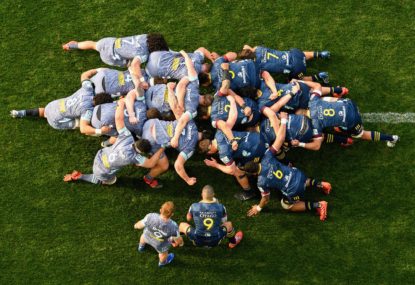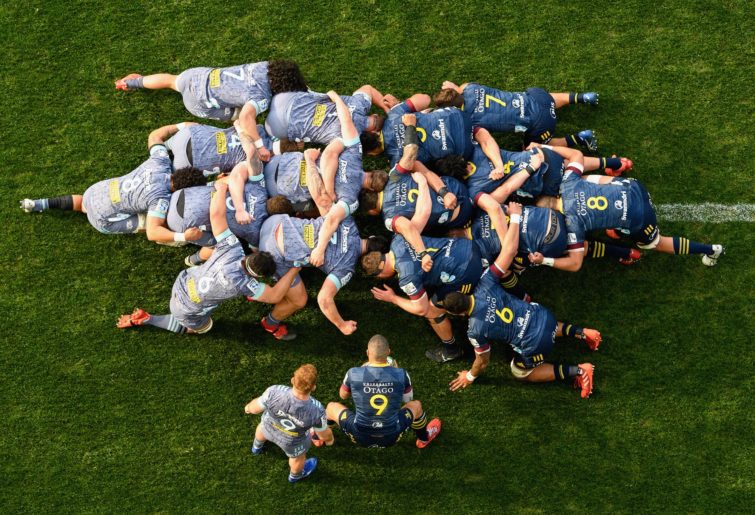1997 Brumbies
new author
Roar Rookie
Opinion

To grow the game, fans need good-quality rugby played by meaningful teams.
This is why the NRC has failed. Although enjoyable for rusted-on rugby fans, the quality of rugby was significantly lower than Super Rugby and didn’t have the engagement of fans the comp needed.
Unfortunately, given the climate, it may never be possible to establish a meaningful second-tier professional rugby competition in Australia. Growing the game’s attendance and participation needs to be as imperative as having a successful national team.
Detailed below is a possible blueprint for Australian rugby moving forward. A lot of these ideas are not my own and have been cherry-picked or altered to fit into what is objectively the best possible outcome for Australian rugby and its supporter base.
Professional rugby in Australia should operate across three windows.
National championship
Similar to this year, an Australian domestic championship should occur that will run concurrently with the Aotearoa championship and the Japanese Top League season.
Where this competition differs from other posts and articles are the teams playing. This competition will feature all five current Australian Super Rugby franchises and an Asia-Pacific side based in Western Sydney. This team will draw players primarily from the Pacific Islands and Asia as well as players with similar heritage and play half its games at Parramatta Stadium and the others between Fiji, Tonga, Samoa, Hong Kong, Singapore and Seoul.
Along with the inclusion of this team will be the Moana Pasifika team into the Aotearoa championship. These competitions will be played as they are now, with a home-and-away round robin format plus two finals.

(Photo by Matthew Lewis/Getty Images)
Super Rugby
Super Rugby will be the second part of the season. This competition draws influence from the European-style tournaments in that sees the teams split into two pools. The championship pool will be played by the top three ranked teams from Australia, New Zealand and Japan following their domestic seasons. The cup pool will also be run featuring the last three team from New Zealand and Australia and the next three best teams from Japan.
It has been noted in recent media reports that the top six Japanese teams could compete with Super Rugby franchises. This format would give an opportunity for the top teams to test themselves and for the corporate element of Japanese rugby used to boost the Australian and New Zealand Super Rugby franchises.
Each team will play each other team once other than the teams from the same national championship, creating an eight-round competition followed by two weeks of finals rugby.
All up, for the Australian and New Zealand franchises these two competitions will take up 16 games and potentially another four if your team plays both sets of finals. This is up from the old Super Rugby season, which was 16 games and three finals. I believe this increase of a single game is minimal in regard to player fatigue as teams won’t have to travel to South Africa or Argentina.
But what about the NRC and Fijian team in Super Rugby? The financial constraints around hosting a Super Rugby team in the Pacific Islands will lead the competition to considerable risk. Even though World Rugby will be helping fund the franchise, it has not been announced how long that experiment will last. The last thing Super Rugby needs is to create a competition only for teams to fold or be abandoned again in a few years time.
That is why hosting these franchises in Auckland and Sydney is the best outcome. The best way to develop the island nations is to create or recreate an Australian academy competition that can run as a semi-professional competition at the same time as the National Championship and Super Rugby.
The Australian academy teams can play against Fiji academy, Samoa academy and Tonga academy as a second-tier competition. These three academies will then feed the Asia-Pacific and Moana Pasifika franchises, creating a wider net for Pacific players and greater depth when moving between amateur and professional rugby.

(Photo by Kai Schwoerer/Getty Images)
Representative season
Finally, the representative season is where I would make the biggest changes (hold onto your hats). Following the traditional three-Test inbound series would be the new Rugby Championship.
The current Rugby Championship would be completely deconstructed and replaced by a tiered Six Nations structure similar to that used in the northern hemisphere but with promotion and relegation – basically a single round robin format – but this new competition would include a final and promotional playoff game. If Australia and New Zealand wanted to play each other for a second Bledisloe Cup, that could also fit in.
Initially the top tier would consist of Argentina, Australian, South Africa, New Zealand, Fiji and Japan, with Tonga, Samoa, USA, Canada, Uruguay and Hong Kong in the second tier. What was a six-game championship would now be only five games for teams that did not make the final or the relegation game. Conversely you could have a seven-team comp with three home-and-away games.
Okay, that seems simple enough, but what about all the Australian players sitting around while the Mitre 10 is on?
Here is where the mooted ‘origin’ series will be placed, but without the drum banging of the league version. This will have more of a city-versus-country feel, with smaller stadiums (initially) without Wallabies and in mostly regional centres.
This series will be contested between three teams: New South Wales, Queensland and a ‘Combined States’ team. This competition is to ensure the best Wallabies-eligible players are still fit and playing if needed in the national side and to get players looking for national honours and a chance to shine in a representative set-up.
Players will play for the state for which they played schoolboy rugby. If they did not play schoolboy rugby in Australia, they will play for the combined team. These teams will play each other home and away. Players not involved in the competition would go back to club rugby, of which most would have already been playing during a lot of the season.
Each team will play two home and two away games. New South Wales and Queensland will play in places like Newcastle, Tamworth, Wollongong and Townsville, while the combined team will rotate between Canberra, Perth, Adelaide and Melbourne – this is to make up for the lack of international games awarded to those cities during the international windows. Rugby should be the game loved in regional Australia nationwide.
Regarding depth, a quick scan of the Super Rugby websites reveals roughly 50 players, a number that is growing each year, currently playing Super Rugby AU are eligible for the Combined States team, with about 11 of those hypothetically unavailable due to Wallabies commitments. A starting 15 could look something like this:
I’m sure New South Wales and Queensland fans would love to see some of the players that have left those states return and play in the colours the grew up supporting.

While it differs from the league version – a point I admit will be hard to sell to the casual viewer – it creates a step up into a representative environment for players. This would hopefully create higher quality rugby than seen in the NRC and draw on the historical patriotisms of each region. Imagine a Combined States teams winning. Absolute scenes.
Following this would be the traditional northern tour consisting of a larger squad with the top Origin performers and Wallabies.
To grow the game rugby must target the minority groups for viewership and players. The NRL and AFL already hold relevance over middle Australia. Rugby should target the European expat community, country Australia, the Pacific and Kiwi community and the Asian community while maintaining the older affluent stakeholders.
This strategy might take time to get results, but it’s rugby’s best chance for growth in Australia at the moment. That’s why it would be a great idea to have the Asia-Pacific team based in Western Sydney, to draw from those demographics while offering an opportunity for elite rugby players outside Australia a chance to play in a high-quality professional competition.
School-age rugby
For school-age growth there obviously needs to be a change to the narrative that rugby is for only the wealthiest private schools. There definitely needs to be a push back into non-rugby-playing private schools – easier said than done.
However there also needs to be a real effort made into the public school system along with girls 15-a-side rugby. This can be done through the ‘sports schools’ scattered throughout metropolitan areas. Rugby needs to think outside the box to get these schools competing against each other in 15-a-side rugby even within condensed competitions. This will be easier if a televised component can be added into a sports public school competition along with the mooted television of GPS schoolboy rugby competitions.
Club rugby
The club rugby season would be played much as it is now, with the various tournaments throughout the states. Ideally these would conclude with the semi and major finals being played in the gap between the end of Super Rugby and the representative season.
From these competitions clubs would qualify for the five-week Club Rugby Cup. Of these, 32 teams from across Australia (depending on finances) would compete in a straight knockout tournament. The competition would consist of eight teams from New South Wales, eight teams from Queensland, four teams from the ACT, four teams from Victoria, four teams from Western Australia, two teams from South Australia, the champions from the Northern Territory and the champions from Tasmania.
In regard to regional teams, I’m unsure about the quality of rugby in various states outside of their premier competitions. However, if deemed good enough, I would love to see champion teams from those areas participate. You could maybe reduce the Shute Shield and Hospital Cup clubs to seven or six each to include these areas.
This competition would obviously need to be funded from somewhere, as the initial travel costs would be extreme. Stan Sport would be the ideal partner if it could cover the initial cost. These players would not be paid, but travel expenses would be covered. If any profits were made, these would be pumped directly into grassroots rugby through the premier clubs or potentially through the state governing bodies focusing on infrastructure development, community engagement and general club expenses.
I have heard many lukewarm responses to this idea. If it were played after the premier competition final games, when teams were still on a high or clubs were looking for revenge as well as the chance to test themselves against the best from around the county, it could make for exciting viewing.
Although I acknowledge that many people couldn’t care whether Brothers or Rats are the best team in Australia, it would mean a huge amount to the supporters of those clubs. History and memories will be made as well as lifelong supporters of the game.
Conclusion
Rugby Australia should be looking to provide this format to the fans of rugby in Australia. These ideas give meaningful competition and pathways to amateur and professional players while providing access to the Pacific, Asian and regional communities.
No doubt many people will challenge this, and I’m sure this format is flawed somewhere, but this is the best way for Australian rugby to move into a brighter future.